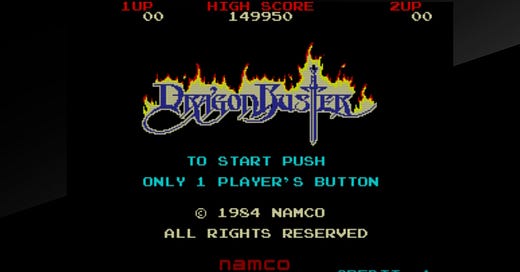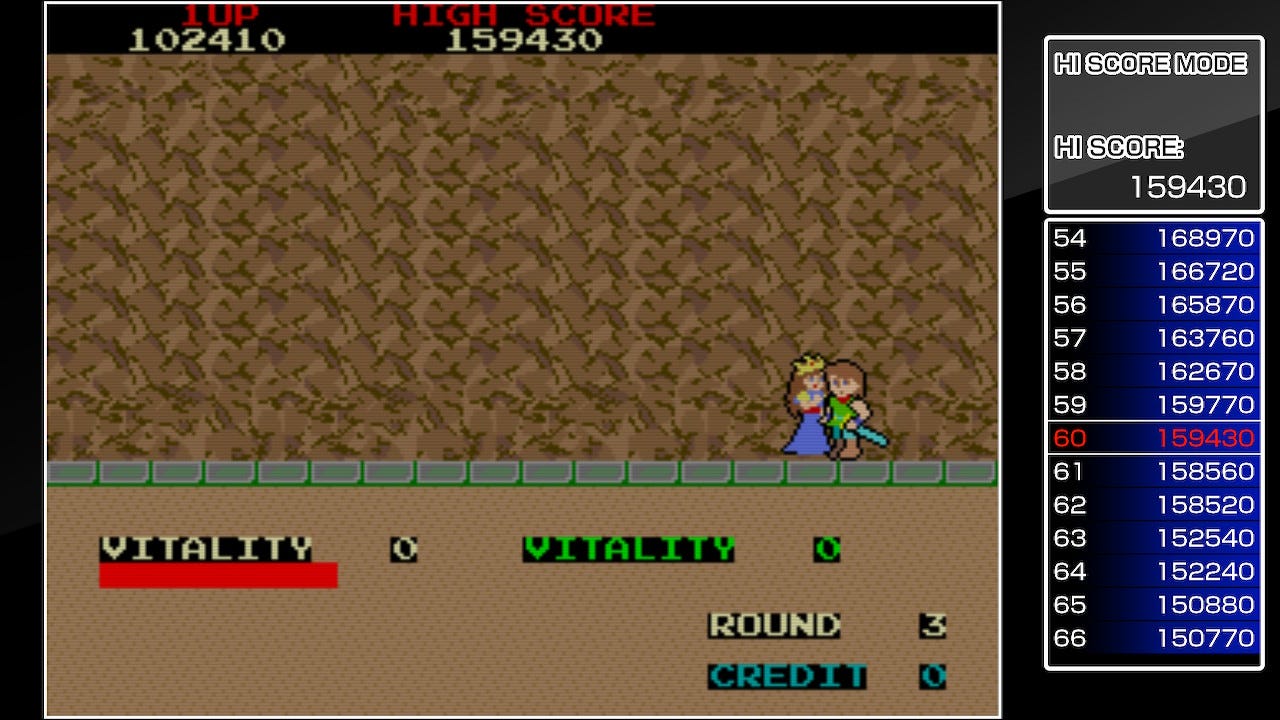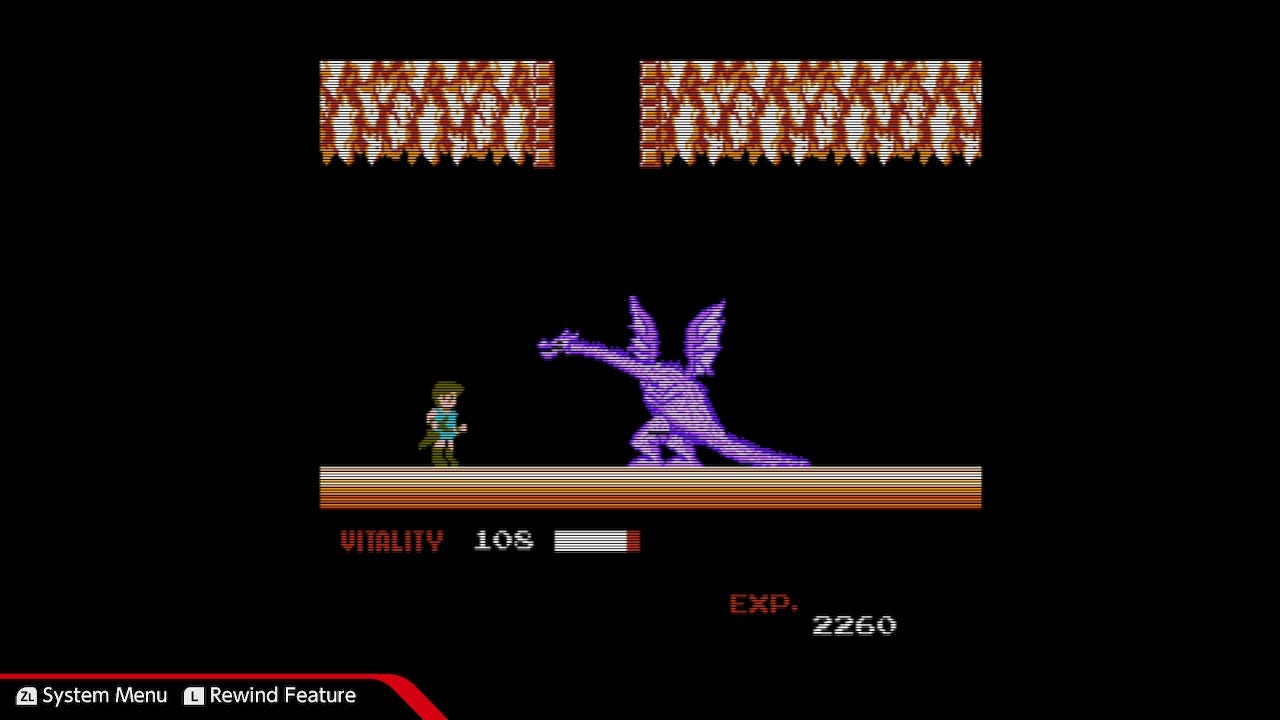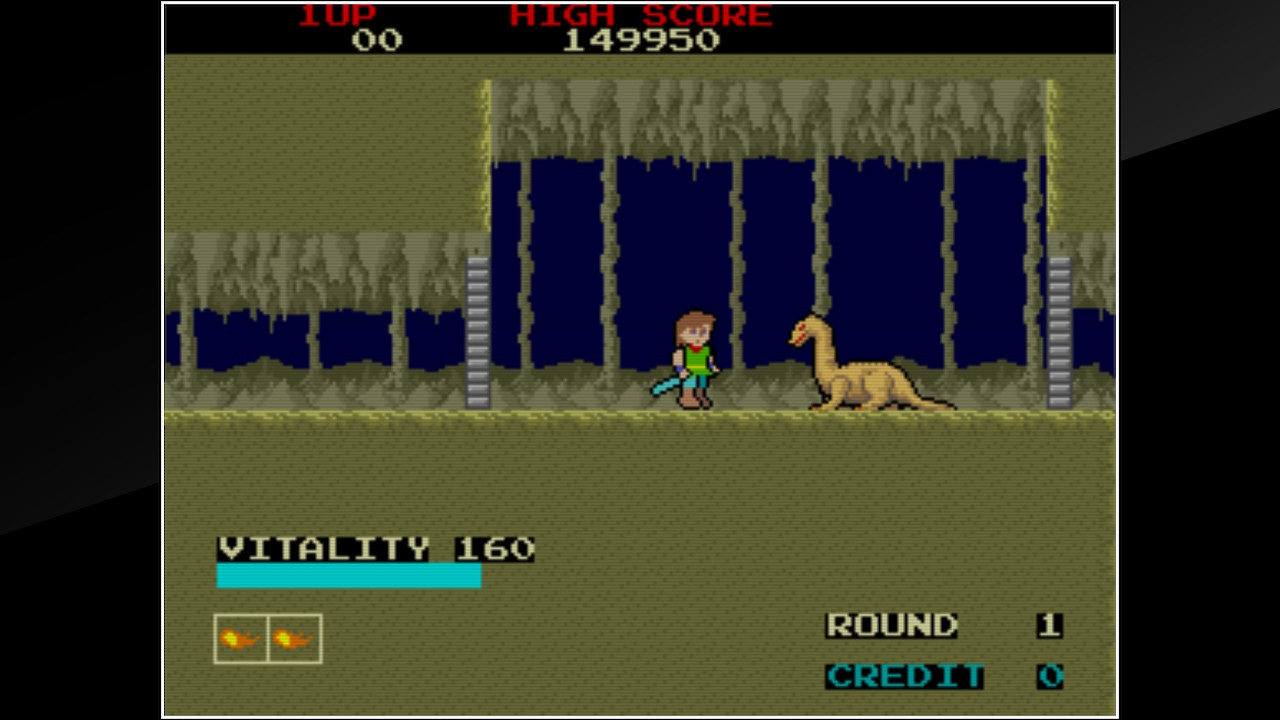It's new to me: Dragon Buster
An early Namco action RPG that's also responsible for a couple of video game firsts.
This column is “It’s new to me,” in which I’ll play a game I’ve never played before — of which there are still many despite my habits — and then write up my thoughts on the title, hopefully while doing existing fans justice. Previous entries in this series can be found through this link.
Dragon Buster isn’t especially well-known outside of Japan, but that’s because it only recently received a standalone international release. While it was an influential action RPG back in 1984 when it landed in Japanese arcades, it never came out in North America outside of as part of a Namco Museum compilation here and there. However, in late-2021, it released as part of Hamster’s Arcade Archives series on the Nintendo Switch and Playstation 4, and this a year after the Famicom port had been included in Namco Museum Archives Vol. 1. There’s basically never been a better time for someone in North America to inexpensively (and legally!) try Dragon Buster out.
In many ways, it does feel its age, but Dragon Buster was ahead of its time in ‘84. It included the ability to dash. It was the first game to feature a double jump mechanic, which ended up being a significant part of the proceedings for far more than just other action RPGs that followed. It was an early adopter of a visible health meter, and showed the hit points for bosses on-screen, too — loads of arcade games had one-hit deaths and multiple lives, which is why they didn’t have a health meter displayed, but Dragon Buster went with a meter that could grow and be recharged, with the trade-off being that you had just one life per credit. The Tower of Druaga, another Namco arcade hit released earlier in 1984, had hit points instead of instant kills, but how many hit points you had and how many were remaining was all invisible — you just kind of had to feel it out, but in Dragon Buster, you could see how close death was, and the music even changed when it was imminent.
Dragon Buster also gave you not just an overworld map in each world — referred to as “rounds” in the game — but let you choose your path, too. Picking one stage at a fork cut off your access to one or maybe even a couple of others in each round, and also plays into the game’s strategy as you learn what kind of stages play like and where some of the game’s hidden items are, well, hidden. That’s quite a bit of depth in terms of player choice and open knowledge of a game’s workings for 1984. It might not always translate to a great time nearly 40 years later for every kind of player, but you can at least respect Namco’s ability to innovate and influence in the number of genres they did at this point in their history.
Xevious, Pole Position, The Tower of Druaga, and Dragon Buster came out in a 24-month span. Xevious’s influence can still be felt in shoot-em-ups released today, Pole Position basically established what an arcade racing game even was and could be, there’s a straight line to draw between The Tower of Druaga and 2022’s generally accepted Game of the Year, Elden Ring, and Dragon Buster helped pioneer various elements of action RPGs, dungeon crawlers, and platformers with its release and success. To put it another way, modern games you enjoy today are in no small part due to what Namco’s developers were up to in the days before the NES had even established consoles as here to stay.
With that in mind, Dragon Buster might seem a little simple by today’s standards as it’s pretty rinse repeat, but even leaving aside its historical importance, there’s fun to be had here if you’ve got patience for games that predate the rise of Nintendo’s and Sega’s dominance of the living room. You play as Clovis, a young knight who has spent quite a bit of time sharpening his skills in battle, whose first real test will come as he sets off to rescue the kidnapped Princess Celia. You’ll do this with a sword whose range isn’t going to cut it, and the help of some magic spells you find along the way.
There are five stage types: ruin, mountain, cave, boneyard, and tower. Ruins are kind of a mix of everything you’ll find elsewhere. Mountains have you start at the top of a stage and descend. Caves have you descend, too, but they’re pretty straightforward, without the labyrinthine nature of the boneyards or towers. Speaking of labyrinths, some stages repeat themselves until you find the specific guardian whose death will trigger the exit to appear. So you can run right again and again and again and get nowhere, basically, if what you’re actually supposed to do is climb down a vine and then go left. That vine will keep appearing, though, like with the Bowser’s Castle stages in Super Mario Bros. that repeat themselves until you pick the right path. Whereas in Super Mario Bros. you just run out of time if you can’t get to the exit in time, in Dragon Buster, there’s an invisible timer that’ll run out, but rather than killing you outright, an enemy you won’t be able to kill with a taste for your blood will enter the stage and start to hunt you down. You’ll, uh, want to get moving if that happens.
Each stage type, regardless of its other qualities, includes multiple guardians to defeat. There are just a handful of them, so you’ll get used to how to defeat them through repetition, but you still want to be careful as they can all do considerable damage and you’ll fight three or more in each stage. When you enter a darkened room, the doors will lock, and a fight with a guardian will commence. The doors will open when they’re defeated (and any underlings in the room will automatically disappear, too) and you can continue on your dragon-busting way from there. Each has a little notable aspect you need to discover and react to. Skeletons have a longer sword than you do, and are impervious to fireballs, so you have to get in there while you can and take your hacks without taking damage back. The small dragons lack wings so will stay grounded, but they’ve got fire: they’re as easy as swinging your sword a few times when they aren’t shooting fire, but if they are, watch out. Wizards control four daggers in mid-air, and they’ll send them slashing after you — you have to time your sword swings to deflect them while being sure not to get hit by another dagger or the wizard’s magic while you do so. Then there are the bishops, who are just the worst, as they have a halberd that keeps you from attacking from the front, and also can shoot magic at you when the halberd is up and their front is exposed. You can do a downward slash at them to avoid the halberd and the magic, but… well, we’ll get into that later.
One of the guardians is guarding the exit — hey, that’s where that name came from — but you don’t know which one until you defeat them. In linear levels, it’s pretty obvious since there’s nowhere else for you to go in any direction, but in the more maze-like ones, you’re praying the next one is it so you can get out of Dodge. It’s not just that exiting the stage is a bonus unto itself since you can move on, but you also have your health bar refilled by 25 percent of your max health each time you complete a level. So getting out with as little damage taken as possible and then having your health meter refill all or most of the way after will keep you going for a long time.
Or, at least, until you find yourself juggled to death. Dragon Buster’s controls can be a little, let’s say, fiddly. You mostly get used to them, but only mostly. It doesn’t always clock that you don’t just want to jump, you want to jump while moving in a specific direction, which can make double jumping to platforms occasionally annoying. This can make leaping over the bishop to perform a downward slash on his head and away from his halberd difficult, since you might end up just jumping in front of him and taking either a halberd or magic to the face. (For the record, this all happens regardless of whether you use a D-pad, analog stick, or even an arcade stick. It’s just inherently fiddly.)
When you take damage, you won’t just get hurt, but you’ll look as if you’re being juggled by foes, and it’s easy to get caught in a situation where your health just melts away because you’re, say, surrounded by four stabbing daggers and a wizard who is also shooting magic at you, and the constantly being hit has you kind of stuck in the air. In the otherwise top-notch Famicom conversion, even dismounting from vines and ropes to end up where you want to can be an exercise in patience and/or futility, as the lack of recognition for direction was brought over with the rest of the game.
The solution to this is to simply try to avoid getting hit. Easier said than done, yes, but it’s the only way. Dash at the wizard before the daggers target you, and hack away. Save a couple of fireballs for the bishop, and set his ass alight from a distance. Slash at the skeleton and then back away to wait for the next opening. Wait for the smaller dragons to stop spewing fire before approaching and slashing. You can do it, it just takes practice to learn the nuances of actually managing it all. And you’ll be especially glad you did when all of these guardians see their health and attack power increased as the game goes on: you’ll need more than just a little luck to pull off a quick win then. You’ll need a plan and the ability to see it through.
Speaking of plans, item drops are random, but there are some that repeat far more often, enough that you can base your chosen paths — both in terms of which stages you want to play and which way you want to go within said stages when given a fork — on their assumed appearance. The mushroom that grants you an additional bit of health, for instance, seems to always be found after defeating the first or second room guardian of the cave right before the round’s boss stage. Whichever of those guardians doesn’t have the mushroom tends to have a potion for recovering health, so if you get the mushroom first, you might even be able to actually use those new hit points right away. As you get used to these sorts of repeat occurrences, you can get a sense of where you want to be going in order to improve your health, inventory, etc. on your way to a boss. Combine that with knowing just how to tackle every opponent, and you’ll start to live a whole lot longer in Dragon Buster.
At the end of each round is a dragon that is definitely all grown up. It has wings, it breathes fire, it can do backflips that let it attack you with its tail, and it’ll jump towards you, as well. It can reach its neck out to try to bite you… there are a bunch of tools in that toolbox, and you will take damage. The key is to just make sure it runs out of health before you do. Use your fireball spells — save your special fireball for these moments, because it can obliterate all the lesser monsters that enter the fight and do a number on the dragon itself, too — and try not to get burned, both literally and figuratively, while slashing with your sword from up close.
Princess Celia can be rescued a few times, if you found and acquired the items to do so adventuring around the other stages. If not, she ends up whisked away by baddies again on the occasions you do find her. Certain items also give you better endings, from a kiss to Princess Celia changing out of her dress and into a bikini that apparently got kidnapped along with her. (I wanted to write, “It’s good to be the (future) king” here, but it’s unclear if Clovis is also a prince, so, this parenthetical will have to do.) The downside is that, in order to carry the items that give you these better endings — the crown and the scepter, which are both dropped by guardians — you have to sacrifice carrying around the sword upgrade or the shield that helps your defense and blocks the daggers the wizard is controlling that are a real pain in the butt for reasons other than that they’re trying to stab you in it. So, you have to decide: do you want an easier go of things due to upgrades, or do you want to make the game harder but see Celia dressed up in a bunny costume because you have both the scepter and the crown? Please don’t answer that question out loud.
There were a few ports of Dragon Buster to various Japanese personal computers, but I want to zoom in on the Famicom one. The Famicom port added a slew of new items and enemies to the mix, which changes the way the game plays in a way that makes it a lot of fun even for people who had played the arcade original to death. While on the whole it’s visually a downgrade — it certainly looks fine, just worse than the arcade version — Clovis’ model has seen a bit of an improvement, especially in how he animates, and some of the enemy sprites are improved, too, both in their look and animation. The backgrounds are drabber and darker, which fits the whole dragon hunting through caves thing better than the brightly-lit arcade edition, sure, but I appreciated all the detail found in that one’s backgrounds, too. Here’s the map from the arcade version of Dragon Buster…
…and the Famicom edition map:
I like that even with a screenshot, the scanlines look busted in “photo” form. How authentic! Leaving aside whatever it is the screenshot did with those scanlines, though, you can see the serious change in sprite size and detail from the arcade original to the Famicom version of Dragon Buster. Things look better, albeit darker and drabber with a straight-up black background, in-level:
Clovis is looking good, though, again, outside of whatever is going on with the scanlines in these screenshots.
There also isn’t any score in the Famicom release: instead, you gain experience for defeating foes. Hitting certain experience thresholds will gain you more max health, but the game doesn’t really make this obvious to you; you kind of just have to keep an eye on all of it as it’s happening. With the experience setup, additional items, and new enemy types, the Famicom port is very much Dragon Buster, but more of it in more ways than one. It’s really a wonderful home edition of an arcade hit, and worth seeking out if you enjoy the original. And it’s pretty easy to do so, since it’s available on Namco Museum Archives Vol. 1, which includes Dragon Buster and a whole bunch of other Namco’s Famicom ports, such as the aforementioned Famicom editions of Xevious and The Tower of Druaga. Neither is the equal to their arcade editions, no, but it’s still Xevious and The Tower of Druaga in quality forms.
In addition, Namco Museum Archives edition lets you rewind back a few seconds at a time, which can be useful just for those infuriating vine dismounts in Dragon Buster, but hey, if you want to erase instances of juggling from existence and try a battle again, that’s what the feature is there for, too. You can also deploy the standard visual options like scanlines and pixel perfect display, while saving your game state for later rather than inputting lengthy passwords or starting over.
The Arcade Archive version is loaded with some typical features, like Hi-Score and Caravan modes, as well as tweaks to the game’s difficulty and display. There are some more specific to Dragon Buster in there, too, like an “autofire” for your sword that’ll constantly swing it as you hold the button down, the ability to change your starting health as well as how much you recover (more or less) after each stage or gain from a mushroom. There are also visual adjustments that help Clovis animate better so he looks correct while running and swinging his sword in both directions instead of just to his left. For whatever reason in the arcade original, Clovis’ sprite looked right when facing left, but while facing right — the direction you spend most of the game in — his left arm just looked… off. Protruding from the background into the foreground like it was a right arm attached to a left shoulder. Check out the above embedded video for evidence of this phenomenon if you want, but either way, just know you can choose to have that fixed in the Arcade Archives release, so Clovis has the correct arms attached on the correct sides at all times.
For whatever reason, this option doesn’t apply to Hi-Score Mode, which has you play the game exactly as it was in the arcade, with the exception of having autofire for your sword on if you want. It’ll mark that you did or did not in the rankings, if you’re sensitive to that sort of thing. You also can’t turn off the game’s slowdown in Hi-Score Mode — you’re really playing the original edition, trying to survive as long as you can to rack up those points.
Dragon Buster wasn’t available in North America outside of as part of the occasional Namco Museum, where it would certainly be overshadowed by games the region knew better, but now you can grab it on its own on your Switch or PS4 for all of $8. And the Famicom edition as part of the oft-discounted Namco Museum Archives Vol. 1 is just a nifty bonus release to have access to at the same time. There are reasons why you might not be into Dragon Buster in 2023 the way you would have been in 1984, sure, but it’s still fun and playable once you get past its quirks, and it’s hard not to see how influential it was, even all this time later.
This newsletter is free for anyone to read, but if you’d like to support my ability to continue writing, you can become a Patreon supporter, or donate to my Ko-fi to fund future game coverage at Retro XP.










Two questions that are driving me nuts. First, underneath “rounds” is the word “credits”. What does “credits” mean? Second, there are times when I can hit the “start button” on my games and vitality is added - why?